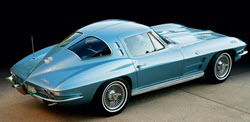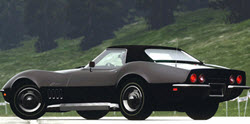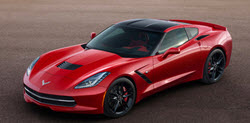The evolution of Corvette design through the decades.
The 1950s: The Birth of an Icon
The Corvette first emerged in 1953, marking a significant milestone in automotive history as Chevrolet aimed to forge a new path by designing a sports car that could stand toe to toe with renowned European models. The original Corvette was a groundbreaking venture, primarily for its revolutionary fiberglass body, a material not typical at the time, offering both innovation and lightweight benefits. The concept and design of the Corvette were spearheaded by the visionary Harley Earl, whose creative foresight enabled this iconic creation. Under the hood, the initial Corvettes came equipped with a modest six-cylinder engine, which admittedly did not deliver high performance akin to its European counterparts. However, these early models were an homage to style, sporting a curvaceous body that gracefully complemented its distinctive mesh grille, setting it apart visually. Despite not achieving immediate commercial success, the Corvette’s potential was unmistakable, paving the way for its evolution into a legend of the automotive world.
The 1960s: Performance and Style Enhancement
The decade of the 1960s was transformative for the Corvette, characterized by substantial gains in both performance capabilities and aesthetic refinement. A turning point was in 1963 when the Corvette Sting Ray was introduced, captivating automotive aficionados with its unique split rear window design. Although somewhat controversial, this feature has since become an iconic emblem associated with the Corvette brand. This era was also notable for the unveiling of the Chevrolet small-block V8, an enhancement that secured the Corvette’s place as a legitimate sports car, significantly improving its power and road performance. Design innovations such as hidden headlights and independent rear suspension not only elevated the Corvette’s appeal but also solidified its reputation for effortlessly blending eye-catching style with impressive performance metrics, setting new standards in automobile design and function.
The 1970s: Adapting to Change
The 1970s were a challenging period for the Corvette, necessitating adaptations to various external pressures. This decade was marked by stricter emission regulations and the prevalent oil crisis, which shifted focus from sheer power to vehicular efficiency. Amid these changes, the Corvette experienced a temporary dip in horsepower, but its commitment to aesthetic evolution remained steadfast. Aerodynamics took precedence in design, resulting in a more streamlined appearance coupled with advancements such as polyurethane bumpers, designed to meet new safety regulations while maintaining aesthetic allure. Regardless of the widespread external challenges, the Corvette managed to sustain its popularity and continued to be emblematic of American automotive innovation and creativity, demonstrating resilience and the ability to adapt to changing circumstances without losing its core essence.
The 1980s: Technological Advancements
In the 1980s, the Corvette underwent a technological transformation, embracing innovations that propelled the model into a new era. The debut of the fourth-generation Corvette in 1984 signified a departure from traditional designs, introducing a more angular form that improved aerodynamic efficiency. This period was also marked by the integration of advanced technologies, including a digital dashboard and electronic fuel injection systems, which significantly enhanced the driving experience by offering greater control and efficiency. Although some purists criticized the design changes for straying from classic aesthetics, the incorporation of modern technology was crucial in ensuring the Corvette stayed relevant and competitive with contemporary sports cars. This decade underscored Chevrolet’s dedication to marrying high performance with cutting-edge technology.
The 1990s: Refinement and Power
The 1990s witnessed the Corvette undergoing further refinement shaping both its design and performance attributes. The introduction of the C5 generation in 1997 marked a renewed focus on enhancing reliability and boosting performance with the innovative LS1 V8 engine. This period was characterized by efforts to minimize vehicle weight and optimize aerodynamic efficiency, resulting in a sleeker, more agile Corvette. This decade effectively reinforced the Corvette’s enduring status as a formidable sports car in the face of escalating global competition. The advancements during the 1990s ensured that the Corvette not only maintained its legacy but also positioned itself as a vehicle with futuristic aspirations, setting the stage for continued success into the new millennium.



